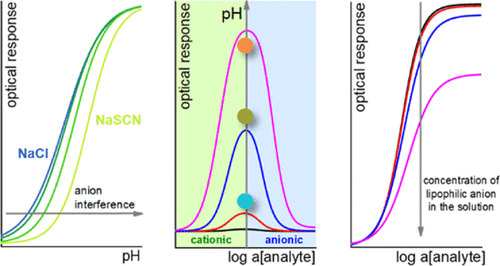Our official English website, www.x-mol.net, welcomes your feedback! (Note: you will need to create a separate account there.)
Influence of Electrolyte Coextraction on the Response of Indicator-Based Cation-Selective Optodes
ACS Sensors ( IF 8.9 ) Pub Date : 2020-10-19 , DOI: 10.1021/acssensors.0c01747 Andrey V. Kalinichev 1 , Nadezhda V. Pokhvishcheva 1 , Maria A. Peshkova 1
ACS Sensors ( IF 8.9 ) Pub Date : 2020-10-19 , DOI: 10.1021/acssensors.0c01747 Andrey V. Kalinichev 1 , Nadezhda V. Pokhvishcheva 1 , Maria A. Peshkova 1
Affiliation

|
Here, we report on systematic investigation of the impact of coextraction of the aqueous electrolyte and anion interference on the response of cation-selective bulk optodes. It is evident that to deliberately manage the properties of chemical sensors and to apply them in routine analysis, one should have exhaustive insight into their operation mechanism. Despite the extensive research in the field of ionophore-based optodes and numerous attempts for their practical application, the understanding of how coextraction of an aqueous electrolyte influences its response characteristics has not been developed thus far. Meanwhile, the electrolyte coextraction determines the detection limits of analogous ion-selective electrodes. A theoretical model based on phase distribution equilibrium is proposed to quantitatively describe the effect of Donnan exclusion failure on the response of polymeric plasticized optodes. The theoretical conclusions are confirmed by the results obtained with Na+/pH-selective optodes based on a neutral chromoionophore as a model system in solutions containing anions of various lipophilicities (Cl–, NO3–, I–, SCN–, and ClO4–). For the first time, it is shown that coextraction leads to a significant shift of the response range of the optodes as well as to nonmonotonic response curves due to the transition from cationic to anionic response. An approach to estimate the coextraction constants of electrolytes from the optode response curves is proposed. The limitations in the applicability of optodes due to co-ion interference are explored. It is found that neglecting anion interference can cause dramatic errors in the results of analyses with optical sensors.
中文翻译:

电解质共萃取对基于指示剂的阳离子选择电极响应的影响
在这里,我们报告系统研究的水电解质共萃取和阴离子干扰对阳离子选择性本体光电二极管响应的影响。显然,要有意识地管理化学传感器的特性并将其应用于常规分析中,应该对它们的运行机理有详尽的了解。尽管在基于离子载体的光电电极领域中进行了广泛的研究并且对其实际应用进行了许多尝试,但是迄今为止,尚未开发出关于共提取水性电解质如何影响其响应特性的理解。同时,电解质共萃取确定了类似离子选择电极的检测极限。提出了一种基于相分布平衡的理论模型来定量描述Donnan排斥失败对聚合物增塑光电二极管响应的影响。Na的结果证实了理论结论。+ / pH选择性光电二极管,以中性发色团为模型系统,在包含各种亲脂性阴离子(Cl –,NO 3 –,I –,SCN –和ClO 4 –)。首次表明,由于从阳离子响应到阴离子响应的跃迁,共提取导致光电二极管响应范围的显着变化以及非单调响应曲线。提出了一种根据光电二极管响应曲线估算电解质共萃取常数的方法。探索了由于共离子干扰造成的光电二极管适用性的局限性。发现忽略阴离子干扰会在光学传感器的分析结果中引起巨大的误差。
更新日期:2020-11-25
中文翻译:

电解质共萃取对基于指示剂的阳离子选择电极响应的影响
在这里,我们报告系统研究的水电解质共萃取和阴离子干扰对阳离子选择性本体光电二极管响应的影响。显然,要有意识地管理化学传感器的特性并将其应用于常规分析中,应该对它们的运行机理有详尽的了解。尽管在基于离子载体的光电电极领域中进行了广泛的研究并且对其实际应用进行了许多尝试,但是迄今为止,尚未开发出关于共提取水性电解质如何影响其响应特性的理解。同时,电解质共萃取确定了类似离子选择电极的检测极限。提出了一种基于相分布平衡的理论模型来定量描述Donnan排斥失败对聚合物增塑光电二极管响应的影响。Na的结果证实了理论结论。+ / pH选择性光电二极管,以中性发色团为模型系统,在包含各种亲脂性阴离子(Cl –,NO 3 –,I –,SCN –和ClO 4 –)。首次表明,由于从阳离子响应到阴离子响应的跃迁,共提取导致光电二极管响应范围的显着变化以及非单调响应曲线。提出了一种根据光电二极管响应曲线估算电解质共萃取常数的方法。探索了由于共离子干扰造成的光电二极管适用性的局限性。发现忽略阴离子干扰会在光学传感器的分析结果中引起巨大的误差。


























 京公网安备 11010802027423号
京公网安备 11010802027423号